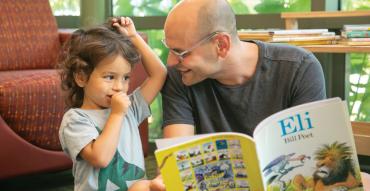Give a child a book and watch them blossom in more ways than you could possibly imagine! Nothing can replace the feel of a book and the turning of pages in anticipation of a story unfolding picture by picture, chapter by chapter. Books open doors to learning and to the world around us.
Where do we go to find these awesome books? The library, of course. The following tips are a combination of common and creative approaches to library visits with a young child in mind.
- If your child has been introduced to books, ask them to choose their favorites. Then have an informal discussion about the books they’ve selected. Suggest that they can find more books like these at a library. Help them get excited about their visit by showing them photos of libraries and telling them about the one you plan to take them to.
- Speak to your child about how to behave at the library. Discuss the purpose of your visit to the library. Explain to your child that libraries are quiet places, but many also include spaces that allow for more noise, movement, and interaction. They need to understand that libraries are for everyone—shared spaces for each person to read, learn, and grow.
- Teach them about borrowing versus buying and what it means to be responsible with books that we are sharing with others in our community. Show them how to hold books and where to keep the books they’ve finished or are waiting to read. If your child is already attending school, their school librarian has probably covered some of these practices. Consider asking the school librarian for the list of rules and procedures; if need be, add a few of your own.
- Establish a relationship with your local librarian—and your school librarian. Ask for a tour of the children’s section and for a pamphlet or calendar with scheduled activities that promote reading. Also, attend school functions and activities that allow you to visit and communicate with your school librarian. The better these librarians know your child, the better they will be at finding books your child loves.
- Observe how quickly your child goes through books to help you determine how often to visit the library. Rushing their reading or taking home too many books at once can be daunting for some children. Other children will devour books, and a visit to the library can’t come soon enough. Either way, allow your child to set the pace, but don’t stop taking them to the library.
- Over time, library visits can become routine. Switch it up to keep your visits fun: choose books on shelves “A” through “C”; find books with a certain colored spine; make lists on bookmarks and check them off as your child reads them. Consider holidays, celebrations, observations, local history, or some area of interest that they have yet to read about.
- Most children listen to stories before learning to read themselves. Listening to a book being read aloud can be a magical experience. A good reader brings the book to life—giving the characters unique voices, often transporting children to an imaginative place. Listening also helps children learn new words and expand their vocabulary. After a read-aloud, listen to your child’s retelling of the story. Use this information, excitement, or lack thereof to choose the next book and future book interests.
- Explore beyond books. Today’s libraries, including the ones in our schools, are often described as the hub or the commons. They have areas where people gather to participate in activities that allow them to innovate, create, and partner with others, such as STEM* rooms or makerspaces. Today’s libraries also have story times, book clubs and sales, free access to computers, digital resources, and activities that engage not just your child, but your whole family.
- Help your child find books that capture the essence of their heritage, culture, and customs. In addition, select books that allow them to see the world beyond their home and community, including how we coexist with and appreciate others. Books like these can be used to guide a conversation about empathy, understanding, and humanity. The best books make us laugh, cry, and think critically.
- Last and most important: read! As parents and caregivers, we often assume that taking our children to libraries will be enough to engage them in book collecting and reading. But the truth is, they’re watching all of us. Find a balance between technology and books. Consider that visits to the library will be memorable experiences, contributing to their autonomy and understanding of intellectual freedom.
Maria G. O’Brien, an AFT teacher leader, is a media teacher at Atlantic High School in Port Orange, Florida, a Florida Power-Library School, and the diversity chair of the Florida Association for Media in Education.
* STEM stands for science, technology, engineering, and mathematics. (return to article)
[photos: Suzannah Hoover]

